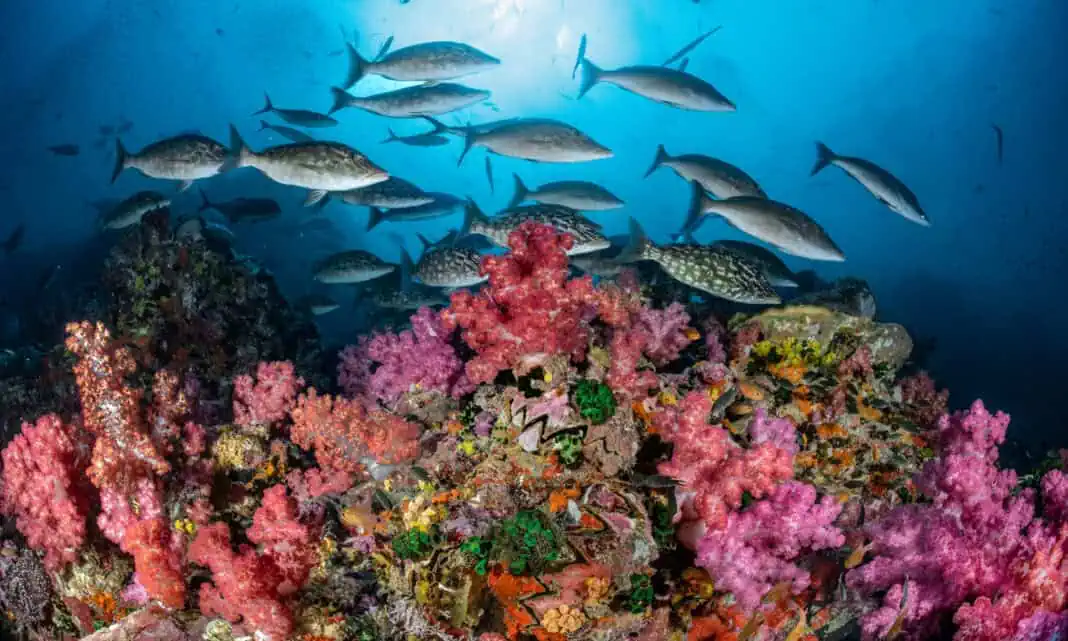Occasionally, a rookie mistake can result in a positive outcome. Such was my situation on our final dive aboard the Thailand Aggressor as we approached the end of our cruise in the Andaman Sea, off the western coast of Thailand.
Everything seemed perfect on this final morning in the Similan Islands, capping off an already wonderful week-long cruise on the Thailand Aggressor. The sea was smooth, super-clear and the early morning sun, slightly muted behind a thin layer of high clouds, would likely provide excellent sunburst photographic opportunities. As a bonus, our boat was the only vessel at the dive site named Christmas Point.
We’d visited Christmas Point earlier in the cruise and I was looking forward to again shooting the wildlife in and around the massive granite boulders strewn around the dive site. The smooth rocks are signature surface and underwater topography features of the Similan Islands.
But things are not always what they seem.

Settling onto the sandy floor at twenty meters between two massive granite boulders, I attempted to test fire my camera to validate aperture and shutter speed settings in preparation for shooting the dive. As I attempted to fire off an image, the lack of a camera response was puzzling and unsettling. Up until now, I’d had no issues with my kit.
Quickly running a sequence of checks, the “err” message on the camera’s LCD was soberingly clear. I had left the memory card out of the camera after downloading my last series of images the night before! Something I would have realized had I completed my gear check before climbing into the dinghy. We’d already dived Christmas Point early in the cruise but, nevertheless, this mistake, would still cost me…Or so I thought.
Without the concentrated burden of searching for viable subjects or scenes to photograph, my eyes and mind were suddenly opened on that final dive to the surprising, spectacular underwater vista which is classic Thailand; outstanding visibility and an underwater waterscape often dominated by granite walls and boulder-falls.
Indeed, I’d been shooting Similan’s granite based reefs for the better part of a week. But, taking in the majesty of this underwater vista before me without the distraction of my manic search for viable photography targets, all under the time constraints of depth and cylinder pressure, was refreshing and enlightening. Metaphorically, without the “burden” of my camera kit, I had the subsurface equivalency of “stopping to smell the roses.”
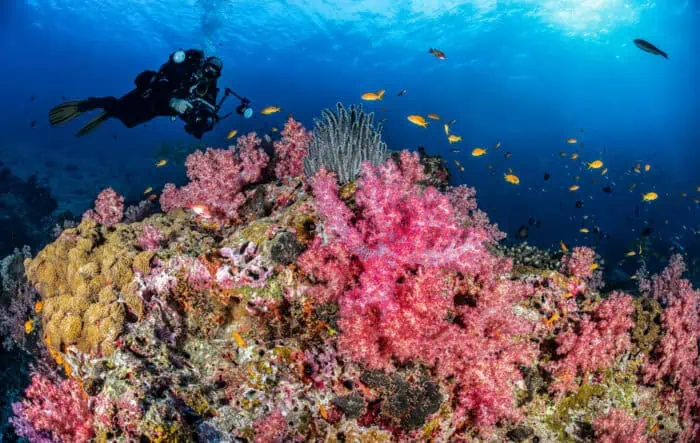
The Similan Islands and associated sea mounts, running up the west coast of Thailand, are mainly composed of “intrusive granitoids,” rocks that formed between 150 and 250 million years ago as a result of plate tectonics which allowed magma to bubble up from deep within the earth’s core to form protrusions and small mountains. Eons of weathering and erosion have left Thailand’s Similan Islands smoothly contoured, creating a unique topography which is extremely popular with tourists and divers alike.
There are eleven “Ko,” the Thai name for Island, in the Similan archipelago, all of which are under Thailand’s protection as a national park. Each Ko has a formal name, however, for the sake of simplicity, they are more commonly known as islands one through twelve locally. During our seven day cruise we visited dive sites along most of the islands along with dive sites at Ko Surin and Richelieu Rock.
We began our journey with an introductory dive at a shallow site called Anita’s Reef between Islands 5 and 6, where classic coral bommies rise up from a shallow sandy plain. The morning light was perfect to capture colorful anthias and damselfish streaming over stoney coral formations. I love shooting into the sun when it’s low on the horizon and the conditions at Anita’s were perfect to capture cool sunbursts as backdrops against the bommies, teaming with life.
Our next dive at Elephant Head Rock, between Islands 6 and 7, was a surprisingly different experience. Elephant Head Rock represents a typical Similan dive site dominated by massive granite boulders. You might expect the boulders to be festooned with corals and sea fans, however, most of the rocky surfaces are oddly devoid of encrusting life. Yet there are sections on every granite reef where an explosion of life seems to spring up for no particular reason forming what can only be called an oasis. At these oasis’, soft corals, stoney corals and massive sea fans abound.
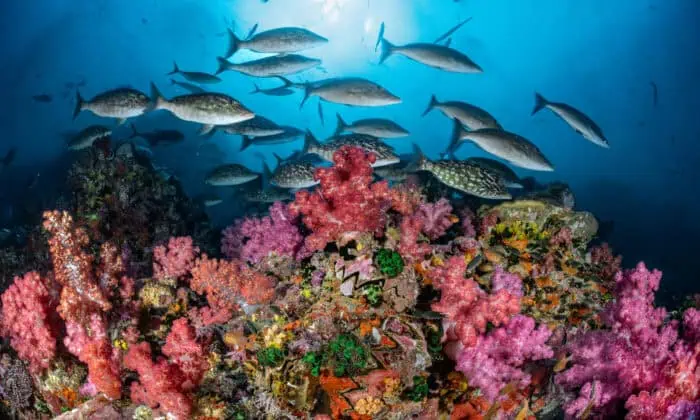
This phenomenon of largely naked rock surface is apparently completely natural and not related to climate change or historical storm impacts (indeed, there are old growth tabling corals on the smooth granite, albeit few and far between). Could it be that the windward facing sides of the islands, being more exposed seasonally are less inclined to promote extensive coral or sea fan encrusting? Over the course of the trip we did find that the windward sides of dive sites, presenting massive rock structures, were largely devoid of corals and sea fans, save the oasis areas, which seem to defy the windward theory logic.
Alternatively, we dived a number of sites which appeared to be within the seasonal lee of an island and provide conditions for much more typical habitat for massive coral bommies and linear reef structures to form.
At Ko Bon (Island number 10) we got the best of both worlds. We entered the water along a windward point and let the current sweep us past the mostly baron rocky slopes, around a boulder-strewn point, to a protected lee-side shore where we found an astonishing developed coral reef.

Almost immediately we encountered an enormous school of batfish hovering in the current, mid-water, which captivated half of our dive group. But I, on the other hand, was drawn to shoot the massive shoals of golden and translucent sweepers, ever shape-shifting, like a single amorphous organism, in and around the stoney coral structures.
On the afternoon of our fifth day we left the Similan Islands for the Surin Islands, an archipelago of five islands, closer to the coast of Thailand but still within the Andaman Sea. At the island of Ko Surin Tai we made an afternoon sojourn to a village of indigenous sea people called the Moken, which are locally known as “sea gipsy.”
The Moken number in just the hundreds, share everything communally and have their own separate language. As people of the sea, their mode of transportation is a long-boat made of hard woods, colorfully painted and propelled by the most unusual engine I’ve witnessed. It appeared to be a single cylinder block engine with a drive shaft at least three meters long, terminating in a double bladed propeller. Throttled at idle speed, you can literally count the “pops” from the single cylinder engine.
After our visit to the Moken village we suited up for a sunset dive along the south shore of Surin Island. Our Cruise Director, Trey, indicated that this fringe reef dive site had a bit more stoney coral development than we had seen in the Similan Islands. His proclamation was definitely under-represented!
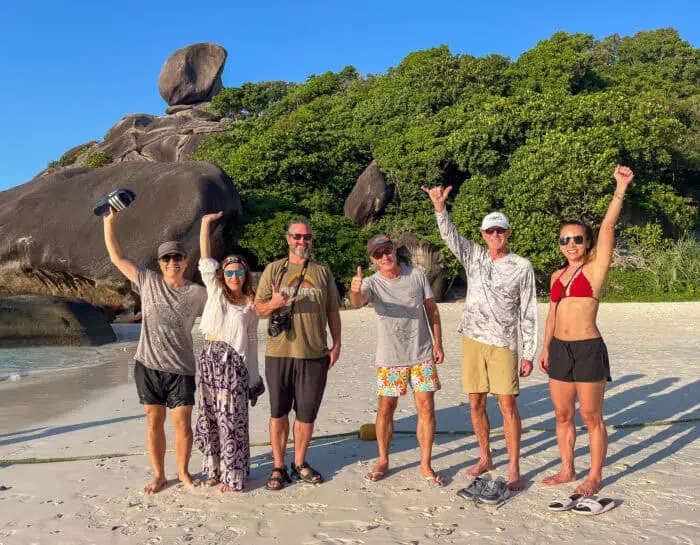
In the gloaming, my dive buddy and I were blown away by the underwater metropolis, starting near the surface and sloping to around 20 meters. The coral speciation was staggering in numbers and their health was surprising, impressive and completely unexpected.
Massive tabling corals, easily two and a half meters in diameter, were complemented by forests of branching stag horn corals, lettuce corals and many other species of smaller plating corals. Between the thickets of coral an occasional Magnificent Anemone, replete with hosting anemonefish, punctuated the dense seascape.
The dive was incredible and only our inability to focus on subjects after twilight, drove us from the water. The surprising old-growth fringe reef at the south end of Surin Island left me perplexed on how this magnificent feat of nature could evade the ever encroaching threat of climate change. Happily, at least for now, there are still places on the planet, bastions if you will, defying the odds of human caused degradation.
The following morning we traveled before dawn to reach one of six mooring buoys off fabled Richelieu Rock, a massive underwater pinnacle barely reaching the surface between the Similan Islands and the Surin Island group. “The Rock” may be the most popular dive site on the planet visited by dozens of boats and hundreds of divers daily, and for good reason.
As an isolated pinnacle in the open ocean, The Rock is swept by unimpeded currents, which support an astounding abundance of life. The signature animals on The Rock include a myriad of pastel colored carnation corals, giant sea fans and impossibly more Magnificent anemones than any other place on earth.

When the current is raging at Richelieu Rock, the side of the rock receiving the brunt of the current, is where everything happens. There, shoals of glass fish are under continuous assault from schools of predator jackfish, long-nose emperor fish, groupers and snappers. Carnation corals of so many pastels swell in the tidal flow, covering every available surface. At the crown of the pinnacle, anemonefish hosting in thousands of Magnificent anemones, fight to keep from being swept away from their symbiant host fixed firmly to the granite rock. Richelieu is almost a theater of the absurd in its beyond-concentrated circus of wildlife.
We make the penultimate dive of our trip at The Rock as the sun is going down. The day boats are gone, and divers have been retrieved from the few other liveaboards still moored on fixed buoys. We selfishly have The Rock to ourselves in the waining light.
Magnificent anemones often fold up into the shape of an onion at twilight. At Richelieu Rock, seeing this phenomenon with hundreds, if not thousands of anemones, was a sight to behold. It was an amazing event, leaving me shooting continuously, until it was time to exit the water.
I had had a lot of images to process after four dives at Richelieu, which is why I might have forgotten to put my memory card back in the camera immediately after completing the download. Thus, I found myself at Christmas Point, completing my last dive with the self inflicted wound which would keep me from shooting yet even more images.
But now, with my eyes and mind liberated to simply observe and contemplate the surprises Thailand’s Andaman Sea exploration offers, my mistake ultimately proved to have a silver lining.
Thailand Aggressor
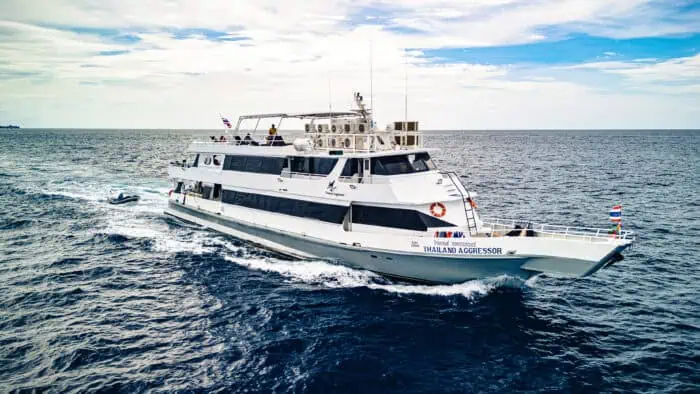
The Thailand Aggressor is an operation “reborn” post Covid pandemic. Everything about the yacht looks brand new, from the scuba tanks, to the dinghies and, the staterooms to the salon, after being recommissioned in October 2024. She offers two voyage routes, season dependent. I selected the Andaman Sea voyage which covers dive sites in the Similan Islands, Surin Island and Richelieu Rock.
The divemasters and the Cruise Director have decades of experience and their “low key” approach gave the divers wide latitude on every dive, something photographers will really appreciate. As long as we were paired with a buddy and carried an SMB, we could accomplish every dive completely on our own recognizance.
The food aboard the Thailand Aggressor was masterfully prepared local cuisine by the yachts’s Thai chef for lunches and dinners, with western breakfasts made to order, which included everything from waffles and bacon to eggs Benedict. In a word, the chef’s preparations were delicious and, the authentic Thai dinners were complemented with a selections of excellent red and white wines!
The Aggressor motto is dive, eat, sleep and the Thailand Aggressor gave us diving on steroids, with five dives per day offered on three occasions. If you are an Aggressor affection ado, you will certainly appreciate the Thailand Aggressor. If you’ve never been on an Aggressor boat, I cannot think of a better first trip to make than on the Thailand Aggressor for the ultimate dive, eat and sleep experience!
Other Helpful Information
Location
When to go
Mid-October to early May is the ideal season for diving the Andaman Sea. This period avoids the monsoon and offers calm seas, peak visibility (up to 30m/100ft), and increased marine life activity.
The best months for mantas and whale sharks around Richelieu Rock are February to April.
Getting there
Fly into Phuket International Airport (HKT), Thailand.
From there, transfer to Tap Lamu Pier, near Khao Lak — the Thailand Aggressor’s departure point (approx. 1.5–2 hour drive north of Phuket).
Most liveaboard operators, including Aggressor, can help arrange pier transfers.
Choosing an adventure itinerary
For more information on the Thailand Aggressor, visit www.aggressor.com, info@aggressor.com and +1-706-993-2531
Other information
The travel planners at Aggressor will apprise you of the latest travel requirements/restrictions based on the most current COVID-19 conditions.
Article By Mark B. Hatter – Mark is a long-time outdoor photojournalist specializing in scuba diving photos and fly fishing essays and feature articles. Over the years Mark’s images, cover shots, and stories, from every continent, have appeared in over two dozen different publication titles, including magazines, books, and industry advertising.
This is a sponsored post – for more information please see our disclosure policy.

